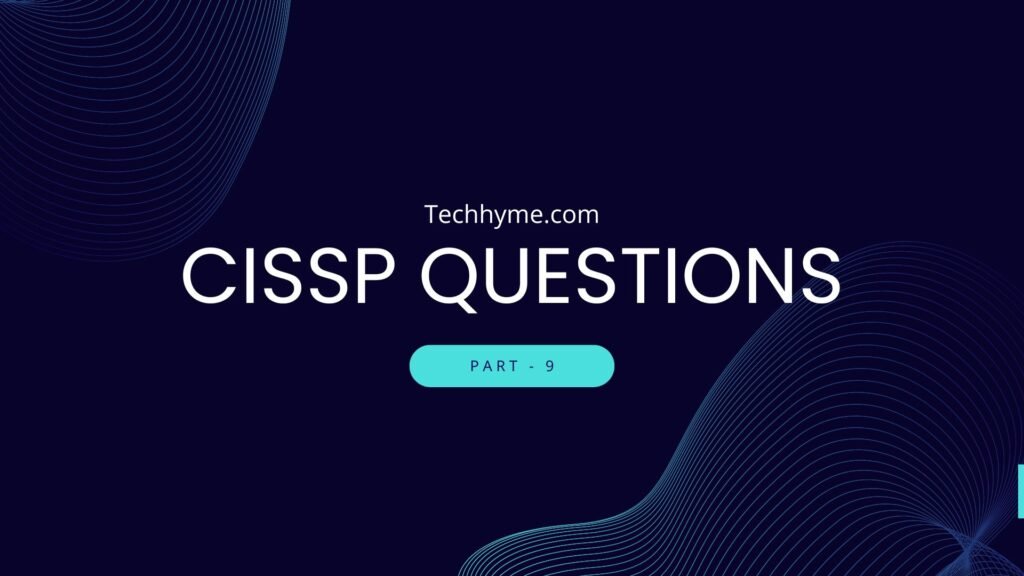Prepare to ace the CISSP exam with this series of practice tests meticulously crafted to cover the breadth and depth of information security topics. Each article offers a blend of theoretical knowledge and practical scenarios to help you master essential concepts and techniques required for CISSP certification.
1. If an attacker sees guard dogs and decides against attempting an attack, what kind of control does this illustrate?
A. Physical deterrent
B. Subject preventive
C. Technical detective
D. Physical corrective
Correct Answer: A
2. Which of the following is a function included in the authentication aspect of AAA (authentication, authorization, accounting) services?
A. One-time password
B. Identification
C. Integrity verification
D. A transponder
Correct Answer: B
3. What term describes a method where an individual convinces an authentication service that they know the password without actually revealing it?
A. A Type I error
B. SESAME
C. A privilege attribute certificate (PAC)
D. The zero-knowledge proof
Correct Answer: D
4. What must be used to connect a network intrusion prevention system (IPS) sensor to a segment?
A. TACACS
B. A hybrid card
C. A supplicant
D. A span port
Correct Answer: D
5. Which control relies on an attacker being unaware of the asset being protected or the existing vulnerability?
A. Provisioning
B. Subject deterrent
C. Security through obscurity
D. Separation of duties
Correct Answer: C
6. When there is a worry that separation of duties may become less effective over time due to coworker familiarity, what should be implemented to manage fraud?
A. Dual control
B. The principle of least privilege
C. Dynamic separation of duties
D. Job rotation
Correct Answer: D
7. Which authentication method uses only symmetric keys and tickets to provide its services?
A. Biometrics
B. Kerberos
C. SESAME
D. The Extensible Authentication Protocol (EAP)
Correct Answer: B
8. Which access control model necessitates the use of unique identifiers for individual users?
A. Discretionary access control (DAC)
B. Mandatory access control (MAC)
C. Role-based access control (RBAC)
D. Rule-based access control
Correct Answer: A
9. If you have doubts about the authenticity of a new employee’s college diploma, what would be the most appropriate action for you to take to confirm their educational background?
A. Examine the diploma’s paper quality.
B. Conduct a credit investigation.
C. Reach out to the college’s verification department.
D. Get in touch with the employee’s provided references.
Correct Answer: C
10. What are two other types of access control mechanisms, besides technical controls, used to manage access within organizations?
A. Physical
B. Turnstile
C. Firewall
D. Administrative
Correct Answer: A
11. Which method is the most robust form of authentication among the given options?
A. Fingerprint scan
B. Retinal scan
C. Iris scan
D. Password
Correct Answer: C
12. Bouke, a security engineer, wants to enhance authentication by adding a smartphone authenticator that utilizes a time-based one-time password (TOTP) to the existing password system. What authentication method is he introducing?
A. Two-factor authentication (2FA)
B. Something you know
C. Three-factor authentication (3FA)
D. Multifactor authentication (MFA)
Correct Answer: A
13. What term most accurately characterizes the utilization of a password for authentication?
A. Something you know
B. Somewhere you are
C. Something you are
D. Something you have
Correct Answer: A
14. Aly fails to access a system using biometric authentication, along with his username and password. What kind of authentication event has taken place?
A. True negative
B. False positive
C. False negative
D. True positive
Correct Answer: C
15. Which of the following is NOT a characteristic of a Virtual Private Network (VPN)?
A. Encrypts data transmission
B. Creates a virtual tunnel through the public Internet
C. Allows remote access to a private network
D. Increases data transmission speed
Correct Answer: D
16. What is the main purpose of the Simple Network Management Protocol (SNMP)?
A. Encrypting data transmission
B. Managing network devices
C. Detecting network intrusions
D. Routing data between networks
Correct Answer: B
17. Which of the following is a characteristic of a stateful firewall?
A. It monitors only the source and destination addresses.
B. It monitors the state of active connections.
C. It operates only at the Application Layer of the OSI model.
D. It does not require any configuration.
Correct Answer: B
18. What type of encryption is used by the Wired Equivalent Privacy (WEP) protocol?
A. RSA
B. AES
C. RC4
D. SHA-256
Correct Answer: C
19. Which of the following best describes the function of a proxy server?
A. It provides a direct connection between a client and a server.
B. It acts as an intermediary between a client and a server.
C. It manages network collisions.
D. It encrypts all data on a local network.
Correct Answer: B
20. What is the primary purpose of the Transport Layer in the OSI model?
A. It provides physical connectivity between devices.
B. It ensures reliable data transmission between devices.
C. It translates data into a user-friendly format.
D. It defines the network topology.
Correct Answer: B
21. Which of the following protocols provides secure file transfer capabilities?
A. FTP
B. HTTP
C. SFTP
D. SNMP
Correct Answer: C
22. What is the primary function of the Network Layer in the OSI model?
A. It manages the physical connection between devices.
B. It ensures reliable data transmission.
C. It routes data between different networks.
D. It translates data into a user-friendly format.
Correct Answer: C
23. Which of the following is a common method used to authenticate users on a network?
A. Data fragmentation
B. MAC address filtering
C. Two-factor authentication
D. ICMP feedback
Correct Answer: C
24. What type of attack involves overwhelming a system with traffic to make it unavailable to users?
A. Man-in-the-middle attack
B. Brute-force attack
C. Denial-of-service attack
D. Password cracking
Correct Answer: C
25. Which of the following is NOT a characteristic of the Transmission Control Protocol (TCP)?
A. Connection oriented
B. Ensures reliable data transmission
C. Stateless
D. Provides error checking
Correct Answer: C
26. What is the main function of the Presentation Layer in the OSI model?
A. It translates, encrypts, and compresses data.
B. It manages physical connections between devices.
C. It ensures reliable data transmission.
D. It routes data between different networks.
Correct Answer: A
27. Which of the following is a security protocol designed to provide secure communication over an insecure network?
A. SNMP
B. ICMP
C. SSL/TLS
D. ARP
Correct Answer: C
28. What type of network topology is characterized by devices connected in a closed loop?
A. Star
B. Mesh
C. Ring
D. Bus
Correct Answer: C
29. Which of the following best describes the function of a demilitarized zone (DMZ) in network security?
A. It encrypts all data on a local network.
B. It acts as a buffer zone between the internal network and untrusted external networks.
C. It manages network collisions.
D. It provides a direct connection between a client and a server.
Correct Answer: B
30. What is the primary purpose of a public key infrastructure (PKI)?
A. To manage public and private keys for data encryption
B. To increase data transmission speed
C. To detect and prevent network attacks
D. To route data between different networks
Correct Answer: A
31. Which of the following best describes the function of a network intrusion detection system (NIDS)?
A. It encrypts data transmission.
B. It routes data between different networks.
C. It monitors network traffic for suspicious activities.
D. It manages physical connections between devices.
Correct Answer: C
32. What is the main advantage of using a Virtual Private Network (VPN) for remote access?
A. It increases data transmission speed.
B. It provides a secure connection over the public Internet.
C. It manages network devices.
D. It routes data between different networks.
Correct Answer: B
33. Which of the following is NOT a function of a firewall?
A. Filtering incoming and outgoing traffic
B. Encrypting data stored on a local network
C. Blocking unauthorized access
D. Monitoring connections
Correct Answer: B
34. What type of network topology is characterized by each device being connected to every other device?
A. Star
B. Mesh
C. Ring
D. Bus
Correct Answer: B
35. Which of the following protocols is used to send email securely?
A. HTTP
B. FTP
C. SNMP
D. SMTPS
Correct Answer: D
36. Which of the following best describes the function of a honeypot in network security?
A. It acts as a decoy to attract attackers.
B. It encrypts data stored on a local network.
C. It increases data transmission speed.
D. It routes data between different networks.
Correct Answer: A
37. What is the primary purpose of the Secure/Multipurpose Internet Mail Extensions (S/MIME) protocol?
A. To manage network devices
B. To encrypt email content
C. To detect and prevent network attacks
D. To increase data transmission speed
Correct Answer: B
38. Which of the following is a characteristic of a stateless firewall?
A. It monitors the state of active connections.
B. It filters traffic based solely on source and destination addresses.
C. It requires extensive configuration.
D. It operates only at the Application Layer of the OSI model.
Correct Answer: B
39. What type of network topology is characterized by a central hub or switch connecting all devices?
A. Star
B. Mesh
C. Ring
D. Bus
Correct Answer: A
40. Which of the following is NOT a function of the Physical Layer in the OSI model?
A. It manages the physical connection between devices.
B. It translates data into a user-friendly format.
C. It defines the electrical and physical specifications.
D. It transmits raw bitstream over the physical medium.
Correct Answer: B
41. Which of the following best describes the function of a security information and event management (SIEM) system?
A. It acts as a decoy to attract attackers.
B. It provides real-time analysis of security alerts.
C. It manages physical connections between devices.
D. It encrypts data stored on a local network.
Correct Answer: B
42. What is the primary purpose of the Secure Hypertext Transfer Protocol (S-HTTP)?
A. To manage network devices
B. To encrypt web communication
C. To detect and prevent network attacks
D. To increase data transmission speed
Correct Answer: B
43. Which of the following is NOT a characteristic of a Virtual LAN (VLAN)?
A. It creates virtual tunnels through physical networks.
B. It encrypts data transmission.
C. It allows devices to be grouped logically.
D. It enhances network management and security.
Correct Answer: B
44. What type of network topology is characterized by a single central cable connecting all devices?
A. Star
B. Mesh
C. Ring
D. Bus
Correct Answer: D
45. Which of the following is a common method used to secure data at rest?
A. Firewall filtering
B. Data encryption
C. Network monitoring
D. Traffic routing
Correct Answer: B
46. Which of the following best describes the function of a security operations center (SOC)?
A. It acts as a central hub for network devices.
B. It provides real-time monitoring and analysis of security events.
C. It encrypts web communication.
D. It manages virtual tunnels through physical networks.
Correct Answer: B
47. What is the primary purpose of the File Transfer Protocol (FTP)?
A. To encrypt email content
B. To transfer files over a network
C. To detect and prevent network attacks
D. To manage network devices
Correct Answer: B
48. Which of the following is NOT a characteristic of the Secure Shell (SSH) protocol?
A. It provides secure remote access.
B. It encrypts data transmission.
C. It increases data transmission speed.
D. It uses public key cryptography.
Correct Answer: C
49. What network topology is characterized by multiple connections between devices, providing redundancy?
A. Star
B. Mesh
C. Ring
D. Bus
Correct Answer: B
50. Which of the following is a common method used to authenticate users based on something they have?
A. Password
B. Biometric scan
C. Security token
D. Security question
Correct Answer: C
51. Which of the following best describes the function of a network access control (NAC) system?
A. It encrypts data transmission.
B. It manages network devices.
C. It controls access to a network based on policies.
D. It acts as a decoy to attract attackers.
Correct Answer: C
52. What is the primary purpose of the Lightweight Directory Access Protocol (LDAP)?
A. To encrypt web communication
B. To provide a directory service for managing user information
C. To increase data transmission speed
D. To monitor and analyze security events
Correct Answer: B
53. Which of the following is NOT a characteristic of the Internet Protocol Security (IPSec) protocol?
A. It provides secure communication over IP networks.
B. It encrypts data at the Transport Layer.
C. It manages physical connections between devices.
D. It uses authentication headers for integrity.
Correct Answer: C



